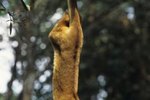
The white-tailed antelope squirrel (Ammospermophilus leucurus) is a type of ground squirrel that frequently lives in deserts. White-tailed antelope squirrels are also known as antelope chipmunks. These wee rodents have furry tails that, as their names indicate, are white on the lower sides. The tops of the tails are either deep gray or black.
Natural Habitat
These small desert inhabitants usually are found in arid settings -- think foothills, shrublands and woodlands with ample juniper and pinon trees. They are attracted to gritty, rugged and sandy locales, as long as the available soil permits the digging of burrows. Burrows are a must for white-tailed antelope squirrels, as they employ them for refuge against both predation and extreme weather conditions.
Diet
White-tailed antelope squirrels feed on a combination of animal and plant sustenance. Some typical components of these diurnal mammals' diet are bugs, seeds, plants, rodents, tiny lizards and the rotting remains of other animals. The seasons also affect what white-tailed antelope squirrels eat. For example, they eat a lot of fruit and seeds during the autumn, a lot of plants in the spring and a lot of bugs for the remainder of the time. Some of these squirrels' plant dining preferences are evening primrose, yucca, blackbrush and acacia. When food is easily available, they sometimes stash it away for later.
Reproduction
The reproductive season for white-tailed antelope squirrels starts in February and ends in June. Litters typically consist of between 5 and 14 youngsters, according to California's Bureau of Land Management. In times of plentiful plants, the litters usually are on the bigger side. The gestational periods range from 30 to 35 days or so. Nursing lasts for roughly two months. Members of both genders attain reproductive maturity once they are a year old.
Predation
White-tailed antelope squirrels' feet are just a tad longer than those of other varieties of antelope squirrels. This makes them swift runners -- a plus for getting out of hazardous predation situations. Some of these squirrels' biggest predators are badgers, owls, hawks, coyotes and bobcats.
Physical Appearance
These usually independent squirrels typically are between 7.5 and 9.5 inches in length, according to the Digital Atlas of Idaho. They usually weigh 3 to 5.5 ounces. White-tailed antelope squirrels typically have gray or brown fur, with white underbellies. Their ears are tiny and somewhat circular.
References
- Smith College Clark Science Center: Ammospermophilus leucurus
- Digital Atlas of Idaho: White-tailed Antelope Squirrel
- Utah Division of Wildlife Resources:
- Southern Nevada Agency Partnership: White-tailed Antelope Ground Squirrel
- Smithsonian National Museum of Natural History: White-tailed Antelope Squirrel
- U.S. Department of the Interior Bureau of Land Management: White-tailed Antelope Squirrel
- University of Michigan Animal Diversity Web: Ammospermophilus leucurus
- IUCN Red List of Threatened Species: Ammospermophilus leucurus
Photo Credits
-
Comstock Images/Comstock/Getty Images




